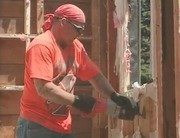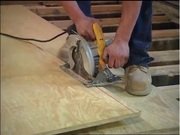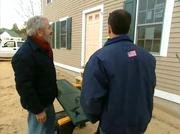Installing the Subfloor
Thorough Construction's lead carpenter Connor McKenna applies panel adhesive to the tops of the new, sistered joists before laying four-by-eight sheets of Georgia-Pacific Plytanium Studifloor on top.
Clip Summary
Thorough Construction's lead carpenter Connor McKenna applies panel adhesive to the tops of the new, sistered joists before laying four-by-eight sheets of Georgia-Pacific Plytanium Sturdifloor on top. This is a tongue-and-groove subfloor that is strong enough to serve as the only layer under hardwood flooring.
Once affixed and locked in place, the Plytanium is nailed to the joists with traditional decks screws, never drywall screws, to create a stronger, better, quieter installation for the hardwood floors that will follow.
Bob Vila: The standard 4x8 sheets of underlayment that we're putting down obviously have to be trimmed every once in a while, and this one's no exception. We're just using a chalk line, and giving ourselves a guideline so that we can rip the sheet down by just a small amount. This is strong stuff. They call it Georgia‑Pacific Plytanium Sturdy Floor, and this is a product that is a tongued and grooved 4x8 sheet that can be used as underlayment in any situation. The beauty of it is you only need one layer for hardwood floor installations, which is what we're going to do here, or for anything simpler like wall‑to‑wall carpeting or vinyl floors or whatever. It's good, sturdy stuff. Fellows, you've got them all now pre‑cut and ready to go, so let's talk about how you do it. Are you putting the panel adhesive on first? Connor McKenna: Yes. Bob: Here it is. That goes along the tops of the newly added sisters. These products are incredibly strong glues that not only help for a better installation, but make for a quieter installation. That's one thing you always want to avoid when you're putting down hardwood floors, is the potential for movement, which causes squeaks. This is one way of avoiding it. The screws that you use for fastening are drywall not wood screws. You want to make that distinction, because you want to make sure you have a sure grip on this plywood. That looks good. Connor, how close together are you going to apply the screws? Connor: Every six to eight inches. Hold that there. Bob: Alright, that looks pretty darn good. As I say, that makes for a real solid floor. Thanks fellas. Connor: Alright. Bob: Let's go towards the front and talk with the plumber. Mario Pagano is back with us this week. Hey. Mario Pagano: Hi, Bob. Bob: How are you? We're removing what is essentially waste and vent pipes from what was a bathroom here, right? Mario: Yep. To take everything back as far as possible, to the existing risers, as we call them. Bob: The change in use of the space is to make this a big kitchen area. Mario: Exactly. Bob: That's going to be a wet wall, so this is right in the middle of my kitchen, and this has to go. This is all venting? Mario: Yeah, that's exactly what it is. It's just to eliminate fumes, sewer fumes as well as pressure. Bob: What's the pressure part of the story? Mario: Water fights air pressure, and that air pressure needs to be eliminated as the water makes its way down by natural gravity. Not only does it eliminate the fumes, it also eliminates the air pressure. Bob: This is what was the trap. We had a sink here last week. Mario: The old pink sink. Bob: This was the waste that went down and this is the vent that goes up from here. Now, can this all be replaced with PVC? Mario: Absolutely not. Not in New York City. Bob: Why not? Mario: Code, and anything under three stories. I am sorry, anything over. Bob: Over. Mario: Exactly. It has to be the cast iron, or galvanized steel, as we see here. Bob: I think that's a good call. You've already started cutting it over here. Mario: We're taking everything out. Bob: Everything out? Mario: Correct. Bob: Last week, of course, we took out everything that was decorative. This was the world's pinkest bathroom, which had an amazing pink bathtub and floor and wall tile. Of course we saved the sink. I'm not sure what we're going to do with the sink. What happens next here? Mario: We took the liberty of supporting everything to make sure it's safe. We're literally taking everything back as far as possible, to possibly re‑utilize just one connection to vent the future fixtures. Other than that, everything goes. Bob: There you go.





